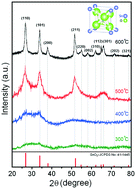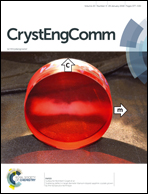The effect of annealing temperature on the structure and optical properties of well-aligned 1D SnO2 nanowires synthesized using template-assisted deposition
Abstract
We report the observations on the structural characterization and the optical properties of SnO2 nanowires post-treated under different annealing temperatures (300, 400, 500 & 600 °C) for 1 h. Well-aligned SnO2 nanowires with diameters of about 100–120 nm were deposited into alumina templates by means of the liquid phase deposition method. The X-ray diffraction (XRD) and Raman patterns of the prepared samples were indexed to the rutile phase of SnO2 without any trace of an extra phase, which was further confirmed by transmission electron microscopy (TEM). The effect of annealing temperature on the optical properties of SnO2 nanowires was studied by using UV-vis and luminescence spectral data. The UV-vis spectra indicated that the absorption edge is blue shifted as the annealing temperature is raised and the bandgap was determined to be 3.32 eV to 3.88 eV. Photoluminescence measurements showed a broad dominant emission peak in the visible region around 450–650 nm. This suggests that the visible emission can originate from defect-related states, particularly oxygen vacancies induced during the formation of SnO2 nanowires.



 Please wait while we load your content...
Please wait while we load your content...